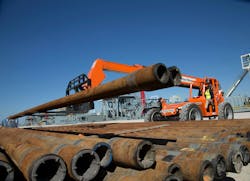United Rentals’ Flannery Says 2025 Better Than Expected with Growth to Continue
With a 5.8-percent increase in third quarter 2025 rental revenue, and a 5.9-percent jump in total revenue, United Rentals CEO Matt Flannery told a conference call with investors that 2025 is going better than the company expected.
“The year is playing out better than expected and our updated guidance reflects the demand environment we continue to successfully serve,” Flannery said. “I expect this momentum to carry into 2026. In the third quarter specifically, we again saw growth across both our general rental and specialty businesses. With optimism from the field and our Customer Confidence Index, we are reinforcing our expectations going forward.”
Specifically, the specialty rental segment of United Rentals’ business posted an 11-percent increase in the third quarter of 2025 with 18 new cold start openings during the third quarter. The company has opened 47 cold start branches through the first three quarters of 2025, with the possibility of topping its goal of opening 50 cold starts this year.
“Our construction end market saw strong growth across both infrastructure and nonresidential construction, while our industrial end market saw particular strength within power,” said Flannery. “We continue to see new projects kicking off, and while data centers are certainly one area of growth, we also saw new projects across infrastructure, hospitals, LNG facilities and airports, to name just a few.”
Flannery noted that United’s end-market exposure by vertical is intentionally diversified, and that its equipment is also fungible enough to ensure the company can serve demand no matter where it presents itself. United’s used equipment market is healthy, and the company is on track to sell approximately $2.8 billion of fleet this year. With business better than the company’s initial expectations, it spent almost $1.5 billion of CapEx in the third quarter and now epect to spend more than $4 billion on fleet this year.
“This positions us not only to capitalize on the current environment, but also for the anticipated growth in 2026,” Flannery said.
M&A pipeline
Although United hasn’t made any significant acquisitions recently, Flannery says the company has plenty of capital to spend and continues to pursue opportunities. “Our M&A pipeline remains robust within both general rental and specialty and across a spectrum of deal sizes. While it’s difficult to predict the timing of M&A, this is an important capability we’ve built over our company’s history, and we’ll continue to use it to enhance our business and drive shareholder value.
“I think we did $20 million of M&A this year. We did one small deal. We don’t predict, forecast, or even plan M&A because I think that’s how people end up doing bad deals. We talk about organic growth and we look at M&A as opportunistic. To be clear, we are always working the pipeline, both in specialty and general rental, and if we find something that fills out our footprint better or a new product that our customers can rely on us for, like matting and mobile storage, we’re going to lean in. It’s just a matter of finding that right deal where it meets all three legs of that stool we talk about: cultural, strategic, and most importantly, financial.”
Flannery was bullish in analyzing the company’s prospects for 2026. “Based on what we see today, 2026 will be another year of healthy growth,” he said. “We believe the tailwinds we’ve discussed throughout this year will carry over, and our unrelenting focus on being the partner of choice for our customers positions us very well to win this business.
“Large projects are really carrying the ball. We feel really good about that. When asked what surprised us, we had a higher win rate than maybe we had originally planned for, and that’s what the additional CapEx was for.”
Flannery added that local markets are “flattish,” with certain markets doing better than others.
“The growth is really coming from major projects which are robust,” he said. “Right now, we call local markets flat. We’re going to go through our planning process for the balance of this quarter. That will inform our guidance, and we’ll get a little bit closer to the local market as we talk to the branch managers and the district managers and they’ll give us their feedback and what they think their growth potential is locally. Then we’ll have a better idea.”
About the Author
Michael Roth
Editor
Michael Roth has covered the equipment rental industry full time for RER since 1989 and has served as the magazine’s editor in chief since 1994. He has nearly 30 years experience as a professional journalist. Roth has visited hundreds of rental centers and industry manufacturers, written hundreds of feature stories for RER and thousands of news stories for the magazine and its electronic newsletter RER Reports. Roth has interviewed leading executives for most of the industry’s largest rental companies and manufacturers as well as hundreds of smaller independent companies. He has visited with and reported on rental companies and manufacturers in Europe, Central America and Asia as well as Mexico, Canada and the United States. Roth was co-founder of RER Reports, the industry’s first weekly newsletter, which began as a fax newsletter in 1996, and later became an online newsletter. Roth has spoken at conventions sponsored by the American Rental Association, Associated Equipment Distributors, California Rental Association and other industry events and has spoken before industry groups in several countries. He lives and works in Los Angeles when he’s not traveling to cover industry events.
